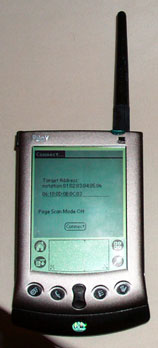April 28, 2000
Palm's New Strategy: Wireless Everywhere
by Shawn Barnett
According to the new executive team at Palm, all future Palm
devices will be wireless, and even existing devices will have a path to wireless via a snap-on adapter.
Meeting with the press on Wednesday in San Francisco, and on Sunday in New York, Palm executives
outlined their vision. "Every Palm is going to be connected to the Internet," said William Maggs, CTO.
He went on to describe their idea of Smart HotSync, where a user can use their wireless access to
select a large file for download, and HotSync would know not to bother using the low-bandwidth connection
to download, instead waiting to download the file when a higher bandwidth connection is available, like
when the unit is in its cradle.
A new Palm based on the the wireless strategy was described: "It's going to be the best looking Palm product
in a long time," said Maggs. It will work with devices like Bluetooth-Enabled cell phones, allowing users to
connect to the internet using the cell phone as a modem, and users will be able to dial phone numbers
directly from the Palm address book. The cell phone could remain on the hip, while the Palm and a Bluetooth-enabled
earbud handle the data and voice duties, all wirelessly.
Later, the prospect of voice enabled solutions was mentioned, including a cell phone/Palm snap on. "It's going to look
a lot like this," said one executive while holding up an OmniSky Minstrel V/Palm V.
I was able to demo a Palm V with a Bluetooth module in a Palm Modem-like package with a large
antenna. The program demoed was a simple whiteboard, where whatever you write on one unit would
almost instantly appear on the other. Communication was bi-directional so we could both write at the same time,
and the data was transferred live. The antennas on the units were large, but we were assured that they will be much
smaller on shipping units; eventually they should be integrated into the bodies entirely.
They also demonstrated a Palm V running PQAs, using an IrDA-enabled Motorola cell phone. It worked at least as fast
as a Palm VII. So their strategy appears to be to release Bluetooth adapters for existing Palm users,
and to come out with Palms that are Bluetooth-enabled out of the box, but it was not clear when each solution would
appear. We were promised announcements, if not products, at PalmSource this year (in November).
|



